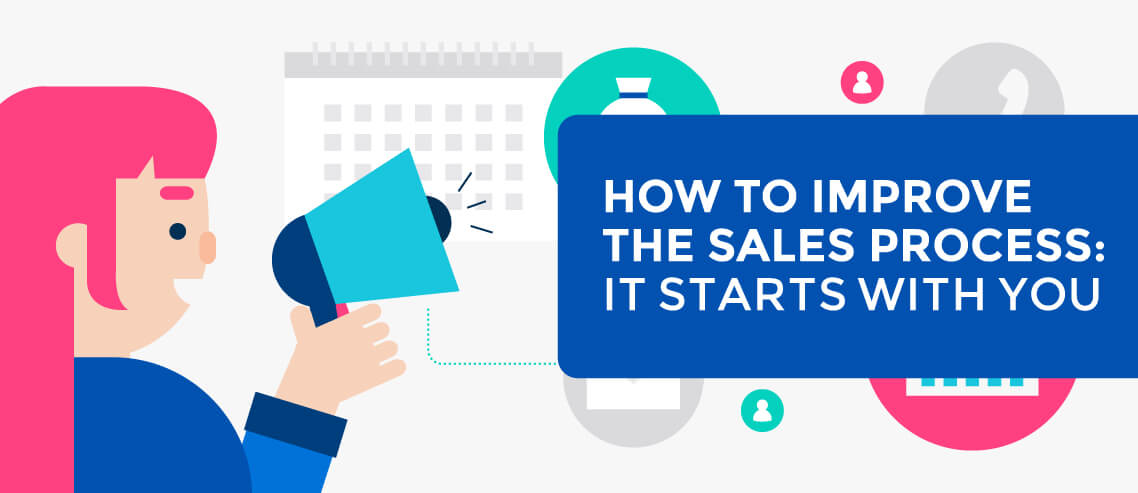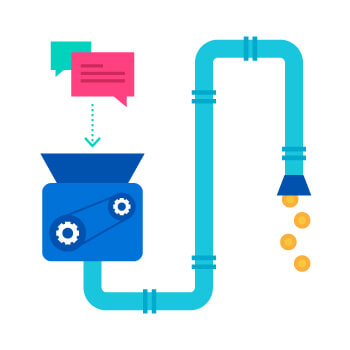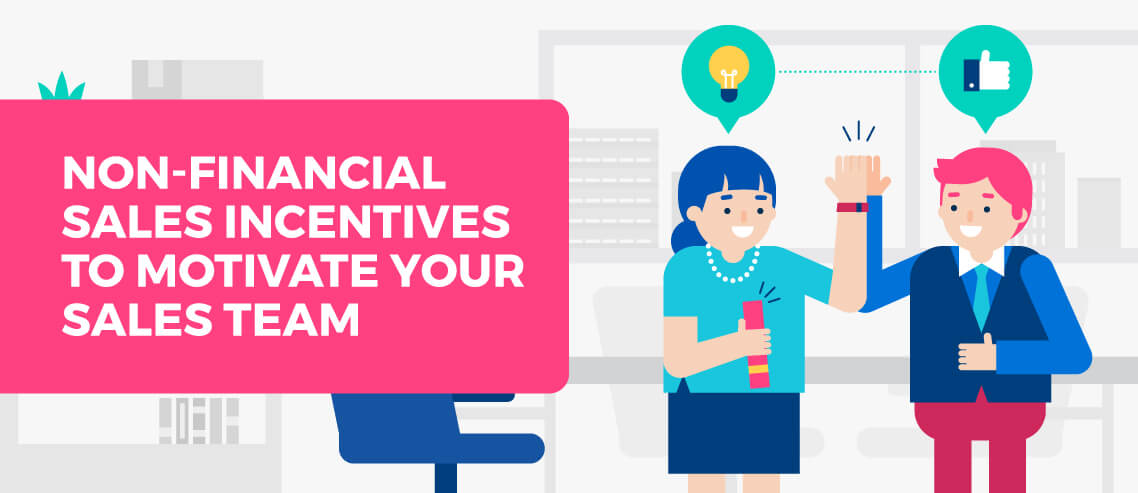How to Improve the Sales Process (Hint: It Starts with YOU)

Contents
One of the fastest ways to improve your sales process is to identify your weaknesses, your strengths, and the outcomes you desire during your walk as a sales professional.
Most salespeople struggle. That’s just the bottom line.
In this article, we are going to address some of the most basic pieces of a sales system that can be re-written in order to change the outcomes for you and your sales organization.
Here is an overview of what we will be discussing:
This isn’t just the starting line, though. These are also some of the most critical elements of a successful sales career. Without having a strong foundation in these categories, you will not have the success you are capable of achieving. Here we will dissect each category while providing concepts and actionable steps to improve your sales process.
Step 1: Mindset

One of the most significant influences in your sales career is your mindset.
In reality, your mindset may be the single most important asset you can develop both personally and professionally.
Yes, your mindset is an asset. It can give you the confidence you need to walk into that giant office, articulate your value, and close the biggest deal of your life. It can bolster you and your outreach methods. And, it can even help you connect with others on a more meaningful level.
However, your mindset can also be a liability.
A negative mindset can weigh you down. It will tell you that the next ten prospects will just say the same thing as the last ten. It can push you into cyclical patterns of negative expectations. It can make you suffer both personally and professionally.
The important thing to remember about a mindset is that you DO have control…
You may have to build it up, like exercise, but it is within your power to change your mindset from a negative and burdensome liability to an invigorating and empowering asset.
Gaining control of your mindset begins in an exploration of self. It is the process of identifying why you do what you do. But it also requires that you tell yourself a new story that highlights your failures and achievements, together as one.
We cannot tell stories that make us seem like a hero to others while avoiding the conversation about our kryptonite. Superman would be nothing if he didn’t have a weakness. People would not have hope in him; they would have expectations of him.
Build hope in yourself by telling your whole story. Embrace your flaws as much as you do your strengths in order to cultivate empathy in your walk, compassion in your step, and confidence in your journey.
It is this symbiotic relationship of duality that allows you to cultivate a strategic approach. Remember, this is a long game and you are playing not only as a sales professional but also as a human being.
Here are 3 ways to start improving your sales process through mindset:
Take 30–60 minutes in the morning and invest it in yourself. We often live lives that are subject to our circumstances. In most cases, this is a choice we make. It is rare for people to take control of their surroundings and cultivate an environment that facilitates success. Setting aside time for you, preferably in the morning, is the first step in being able to make your life what you want it to be. Remember, the morning sets up the rest of your day.
Use your lunch break to connect with people on a deeper, more meaningful level. In essence, we are telling you to never eat lunch alone. Sales is an emotional rollercoaster. A community mindset and the action fellowship will help to keep you grounded in reality and focused on the bigger picture behind your goals. What better time to recharge and continue to build alliances than over lunch? It’s a classic way to bring people together.
Educate yourself in a subject that you love. This is not work. This is about having a passion for something, even if it is not what you do for a living. This is the practice of intentionally observing what is important to those you are looking to serve. Whether it’s a better understanding of your product, your prospect’s entire business ecosystem, or topics that might be outside of your scope of work. People will be attracted to your enthusiasm and knowledge. Be willing to learn. Be willing to share it.
Step 2: Prospecting

Why does prospecting seem to be so hard yet SO important to the survival of our sales walk?
You will not reach the levels of success you desire without having a clear and effective prospecting strategy. You cannot just randomly bounce between office buildings and strip malls.
You need an outlook that is designed to:
- Build relationships, and
- Put people into your Living Pipeline
RELATED: The Modern Salesperson’s Guide to B2B Sales Prospecting in 2019
You need to develop your storytelling skills and give people a REASON to listen to your tale. You need to wander your territory and be a champion for your community.
The way to accomplish this is by forgetting everything you think you know about prospecting.
Let’s start fresh with a 21st-century context for successful communication in a business setting. That means we need to accept that buyers are tired of the games. We need to know they are increasingly looking for genuine people who put service first.
That means laying aside the agenda ridden mico-agreements that are scattered throughout your sales pitch. It means putting the relationship above everything else and dropping your attachment to your commission check. Get rid of the toxic tactics of the 1970s sales guru’s — they are no longer relevant.
Instead, let’s focus on a new form of interaction. One tied to the foundation of the basic principles behind communication theories and the psychology of the human being that you are calling on. A simple yet disruptive approach (in a good way).
When you get someone on the phone for the first time, they are cold, they are disconnected, and they are not really listening from the moment you begin to barf your pitch over the phone.
The same goes for account executives making door-to-door sales calls. Prospects can smell your sales stench from the parking lot before you even got to the door. Why is this? Because 1,000+ times a month they are cold called by some random salesperson in some random sales vertical, and you are all the same.
You walk the same, you talk the same, you pitch the same.
Also, you are misaligned from the moment you start your pitch to set an appointment. Imagine that you are at a party and you walk up to the person giving out red solo cups…
Person Giving Out Cups: Hey there, can I help you with a cup?
You: Hi, my name is Bob, and it is a pleasure to meet you. I am offering financial freedom for you and your loved ones. My products and services are guaranteed to provide an ROI, we are rated #4 in the world for best customer service, and all your neighbors are using me. Can we get you signed up today?
There is literally NO alignment in this conversation and this is what happens every time you cold call someone.
It doesn’t matter if you are asking to speak to the decision-maker or you are asking the decision-maker for an appointment. It all sounds the same. Unless you catch that person in a weak moment or they are literally right in the middle of taking bids, you are probably getting hung-up on.
So how do we separate ourselves from the pack?
We apply the concept of “introducing ourselves” in a manner that causes curiosity. How do we let the prospect know who you truly are and not what they perceive you to be?
Think of Radically Educating your prospecting instead of boring them with your mindless chatter. Think of telling stories with your outreach in order to activate the brain on all cylinders instead of running 90 MPH into a brick wall of NO.
Here are 3 ways to start improving your sales process with prospecting:
Start integrating your story into your sales pitch. The purpose of a story is to ignite the brain and make people engage with you from a different point of reference. Make your story relevant to your prospect and the pains they’re experiencing that you can relieve. Make it meaningful for the conversation you’re having. Make it blur the line between personal and professional personas. You are not separate from your 9–5, make sure people know it.
Listen more than you speak. In other words, build your active listening skills and seek to read between the lines. What you see may not be what’s really going on. For example, “not interested” can mean a host of different things, none of which legitimately means “not interested.” People use common phrases like this one to move the conversation in the direction they want. Look to discover the real meaning behind people’s words.
Use a first touch piece. It’s the 21st century. There is no need to call a prospect who is so cold, they could give you frostbite. Utilize a pre-contact strategy that will create a sense of curiosity in your prospect before you ever reach out to them. But be aware: A brochure or flyer doesn’t count. Everybody sends those; they end up in the trash. Create a marketing piece that expresses your personality and unique value while empowering your sales goals. Then, send it to them before you ever call.
Step 3: Pipeline

Why is a pipeline so important yet oftentimes SO inaccurate?
The truth is most salespeople focus on short-term rewards and never develop a communication strategy that supports long-term career growth. Most times, this unknowingly creates communication patterns that have negative effects on your mindset and your outcomes.
Think about this…
Your communication patterns are the overlords of our conversations. It is our conversations that allow us to measure where a prospect is in their buying process. But, in most of these dialogues, the buyer lies to us.
Why? Because the stereotypical salesperson is untrustworthy, and a short-term outlook has changed our focus and resonates in our communication.
This causes pipelines to become inaccurate, forecasts to become false, and salespeople to go gray and bald at 26 years old. (This is just an average; don’t worry.)
So, replace the buyer-seller dance with transparent communication. Show the prospect that you are not like the other 35 people who made it past the receptionist. You have to respect these people in the same manner that you respect you friends and loved ones.
RELATED: 4 Simple Steps to Building the Perfect Sales Process
Again, I cannot overstate the power of respecting the person in front of you. It will redefine your approach and your ability to connect with people.
There’s just one caveat. You have to be able to communicate this to them in a way that they will receive.
Remember, no games! Here is an example of both GOOD and BAD communication with a prospect.
Queue the beginning of your first meeting:
Salesperson: So we sat aside 15 minutes today to speak about XY and Z processes to figure out how we can help you to eliminate any current issues with our super amazing products and services… Pending everything we present to you today looks good and you don’t have any objections, could we discuss moving forward with our solution at the end of this meeting?
Prospect: *game on, salesperson*
Instead, ask your prospect for the truth! And, tell the truth to them! Here are some ideas…
Note: The calendar invite you sent is for 15 minutes. Your prospect isn’t dumb. They committed to this time.
Salesperson: I appreciate you taking the time today to speak with me so we can learn more about each other’s businesses. I know the agenda was attached to the invite but, was there anything else you wanted to add to our meeting today? Cool! So ill just level with you right now. At the end of our talk, it would be really helpful for me to hear your decision-making timeframe and any snags you see getting in the way of us moving forward. Ultimately, I would love to earn a relationship with you and create a culture of transparency between us. I believe that makes for better business and helps to build credibility and allow for a much smoother sales process. In the end, whether or not we are the right fit for each other will be up to both of us.
Prospect: *I think I’m in love*
This dignifies the individual you are speaking to and honors them. It shows respect. On top of that, it communicates trust and helps them to understand that they have a responsibility as well.
Your prospect is used to salespeople who play little games that favor the salesperson. Interrupt their patterns and begin redefining their expectations.
This is how you build a healthy outlook for future business and forward motion in your sales career as it pertains to your Living Pipeline. You don’t want to be wondering, “When will this deal close,” or telling your boss, “They are buying this month,” and then six months later, “I swear to all that is Holy, they are buying this month!”
A pipeline should be cared for as a living and breathing entity in your sales walk. Having a 30/60/90-day funnel is a death sentence without a 5-year outlook on opportunities that will arise as time drifts by. Change your mindset, change your prospecting habits, nurture and care for your pipeline, #changethegame.
Here are 3 ways to start improving your sales process through pipeline:
Redefine your territory/list. Know that your territory/list is more than just a source of potential opportunity. It is a representation of many different people, and these people are tired of being treated as a means to an end. Be a champion to your community and a protector of your prospect’s interests. Drop the agenda and look to truly serve. Then watch the opportunities grow.
Create a hybrid outlook. Too many salespeople focus on the short term and forfeit opportunities that have not yet come to fruition. Create a five-year outlook. Who’s going to be your client three, four, and five years from now? Create a 2-year campaign that has quarterly touchpoints. The aim should be to build a relationship with this prospect not to show them the latest offer for 20% off. By taking this approach, you will win business sooner than it is “up” while cultivating a much healthier 30/60/90 day funnel.
Build community. This is the Jedi move for your long game. This is about recognizing that your value proposition is you and your ability to bring people together, solve problems, and give back. All of these actions build your reputation — a highly overlooked piece of the puzzle for long-term sales success. Start building a reputation you can be proud of and your prospects feel honored by.
Bottom Line
To improve your sales process, you need to level up your selling skills, sure. But you also need to level up your “self” skills.
The modern seller doesn’t just try to get the deal. Real success is about building relationships that outlast any product or brand. It’s about learning how to communicate clearly and honestly. It’s about laying aside the games and being human.
It’s easier than you might think to improve the sales process. Just start with you. Work on your mindset. Change the way you prospect. And build a Living Pipeline.





